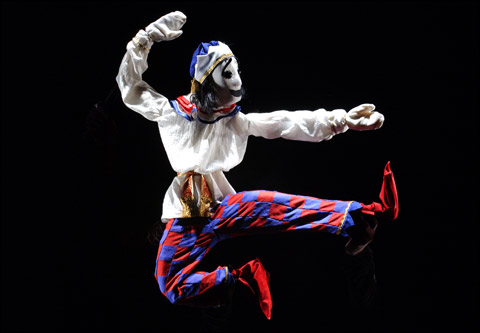
ANTI-GRAVITY BLISS In Twist’s Petrushka, the puppeteers make their charges simulate not just dancing but the original Michel Fokine steps. |
Puppetry is as old as theater itself. The Greeks practiced it; so did the Chinese and the Japanese. There have been highly developed forms in Bali and Java and all over Southeast Asia for centuries. Probably there's no culture on the globe that doesn't have some form of puppet performance. Scholars and psychologists have offered explanations for puppetry's potent grip on the imagination — the need to project and control one's alter ego, the desire to preside over a toy universe, the power of intermediary figures who can communicate with the gods. And in spite of what films, computers, and digital tools can do, live puppetry seems more popular today than ever.
ArtsEmerson and the Celebrity Series have brought us a great contemporary example in Basil Twist's Petrushka (running through Sunday at the Paramount Theatre). A double entendre — a puppet show about puppets — Petrushka has its roots in ballet, carnivals, and Russian folklore. The hero is the classic misfit who suffers and dies but lives on to haunt his greatest tormentor, the Magician to whom he's enslaved. In this production, all the action takes place inside a booth within the theater's proscenium, just as it would in a Punch and Judy show. Instead of marionettes on strings, we get puppets manipulated by an invisible team of nine handlers.
In keeping with its miniature scale, this Petrushka uses a two-piano reduction of the wonderful score Igor Stravinsky wrote for the 1911 ballet, and it's played spiritedly by the Russian twin-sister duo Irina and Julia Elkina. Instead of the crowds that swirl around a Shrovetide fairground in the ballet, Twist reduces the cast to three puppets and a bunch of visual effects. This by itself is a brilliant solution. Films and even ballet companies can summon up the fair in a realistic way, with peasants and coachmen and dancing girls and drunken merchants shouldering one another out of the way to see the sights. Twist simulates all this hubub with glowing pinwheels and vivid red and silver scarfs that whip through the air.
These effects, like the entire play, are artfully synchronized with the music — choreographed, you might say. And if you know Michel Fokine's ballet, the scenario follows it accurately enough to trigger the on-stage action in your mind. The human characters, the woebegone clown Petrushka, the vain Ballerina he loves, and the crude Blackamoor, are the property of a diabolical Magician, who appears only as a pair of large hands hovering over them and dictating their actions.
Perhaps because the three puppets are the only human characters, their dances are truly magical against the cartoonlike objects that represent the bustle of the fair. It's quite uncanny how the puppeteers can make their charges simulate not just dancing but the original Fokine steps. And more.
Petrushka, crooked and ugly, does grotesque jumps and acrobatics to impress the Ballerina. She towers over him on her pointe shoes, gliding and floating in anti-gravity bliss, as no real ballerina can. She flirts with both Petrushka and the Moor; you can see this in the way her plush, elongated body moves. The Moor is a bit hunched and apelike, and slow to figure out just what she wants; his whole body shrinks in astonishment, then surges up to attack when Petrushka appears to interrupt his clumsy attempt at partnering her.